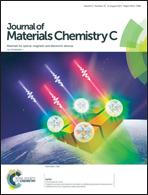Long-lasting phosphorescence with a tunable color in a Mn2+-doped anionic metal–organic framework†
Abstract
Luminescent metal–organic frameworks (MOFs) have received much attention due to their structural tunability and broad range of light-emitting applications. The fluorescence emission of such inorganic–organic hybrids can be significantly tuned by the encapsulation of guest species such as cations, anions, vapors, and dyes. In contrast, the phosphorescence tunability for MOFs has rarely been reported. In this study, an anionic MOF [CdLi(IPA)2](Me2NH2) (IPA = isophthalic acid, Me2NH2 = dimethylamine), denoted as AMOF-1, was prepared via a solvothermal method. The as-synthesized MOF exhibited green long-lasting phosphorescence (LLP). The single-crystal structural analysis revealed that the AMOF-1 channels were lined with the π-electron-rich phenyl rings of IPA and were occupied by exchangeable (Me2NH2)+ guest cations. Based on a facile cation exchange with Mn2+ at different concentrations, the LLP performance of AMOF-1 could be further adjusted across an unusually wide range from blue to violet, white, yellow, orange and red. Furthermore, the reversible changes in the LLP emission indicated that AMOF-1 could also serve as a Cu2+-responsive “on–off” phosphorescent switch. Therefore, this study not only provides a facile way to develop a new type of multi-color LLP materials, but also a strategy to obtain a cation-responsive sensor based on an anionic MOF.



 Please wait while we load your content...
Please wait while we load your content...